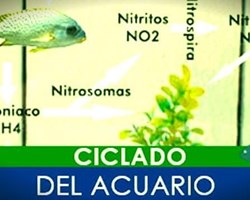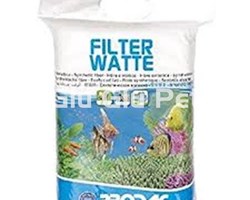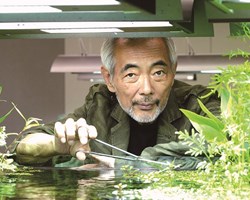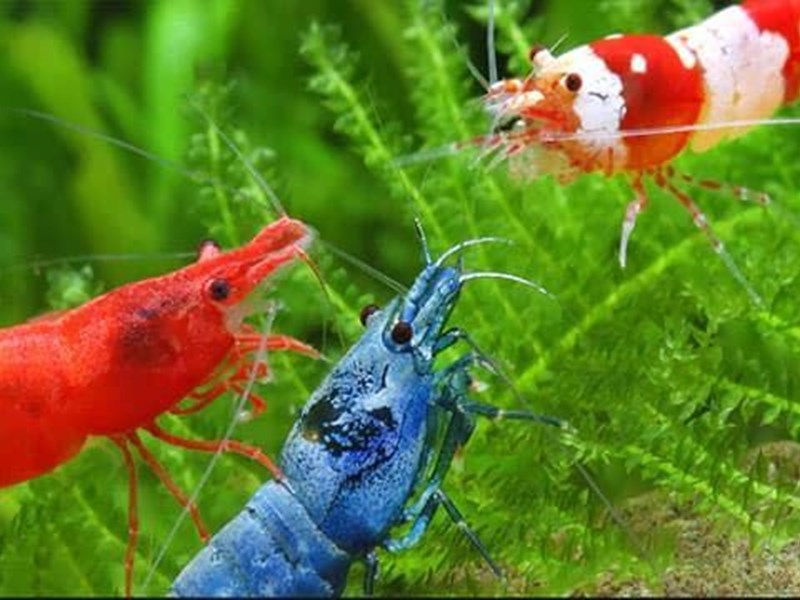
INDEX:
1.- BASIC MATERIALS TO ASSEMBLE A PLANTED SHRIMP.
1.1.-THE AQUARIUM FOR PRAWNS.
1.2.- FILTER FOR YOUR SHRIMP.
1.3.- TEMPERATURE OF THE SHRIMP.
1.4.- HEATER FOR THE GAMBARIO.
1.5.- FANS FOR THE GAMABARIO.
1.6.- SUBSTRATE FOR GAMBARIO.
1.6.1.- INERT SUBSTRATES.
1.6.2.- SUBSTRATES FOR PRAWNS.
1.7.- ILLUMINATION OF THE GAMBARIO.
1.8.- THE WATER OF THE GAMBARIO.
1.8.1.- PH OF THE GAMBARIO.
1.8.2.- KH OF THE GAMBARIO.
1.8.3.- GH OF THE GAMBARIO.
1.8.4.- THE TDS.
1.8.5.- THE CHLORINE OF THE WATER.
1.8.6.- AMMONIA, NITRITES AND NITRATES.
1.8.7.- CHANGE THE WATER VALUES.
1.8.8.- SALTS FOR PRAWNS.
1.8.9.- OSMOSIS EQUIPMENT.
1.9.- PLANTS FOR THE GAMBARIO.
1.9.1.- BEST PLANTS FOR SHRIMPS.
1.9.2.- PLANTS NOT RECOMMENDED FOR SHRIMPS.
2.- TYPES OF PRAWNS FOR YOUR SHRIMP.
2.1.- NEOCARIDINS.
2.2.- CARIDINES.
2.3.- GHOST SHRIMP.
2.4.- CARIDINA DENNERLI (SULAWESI).
3.- NUTRITION OF PRAWNS.
4.- REPRODUCTION OF PRAWNS.
5.- CARE OF PRAWNS.
6.- FISH THAT COEXIST WITH PRAWNS.
7.- PRAWNS DISEASES.
1.- BASIC MATERIALS TO ASSEMBLE A PLANTED SHRIMP.
1.1.-THE AQUARIUM FOR SHRIMPS:
Small aquariums are often problematic as they tend to be less stable and can cause variations in water parameters. If with fish it is already an inconvenience, with shrimp it is even more so.
The bigger the better. If you still don't know where to start, at Glu Glu pet we recommend an aquarium of at least 30 liters.
Remember: the larger the aquarium, the more stable the shrimp will be.
The location of the shrimp is very important:
You should not place the shrimp near a window.
It can affect the temperature and the proliferation of algae due to the sun's rays.
Avoid placing the prawn near an air conditioning and heating device, as sudden changes in temperature can cause the death of your prawns.
For your convenience, it must be accessible for maintenance.
Look for a stable and level piece of furniture that is capable of supporting the weight of the shrimp.
From a 40 liter you will have enough space to keep your shrimp and it will be much easier to fix the mistakes you make as a beginner.
As an added bonus, the price difference for a larger aquarium is usually not too great.
If you prefer to grow plants with low requirements in your shrimp tank, an aquarium kit with LEDs is enough.
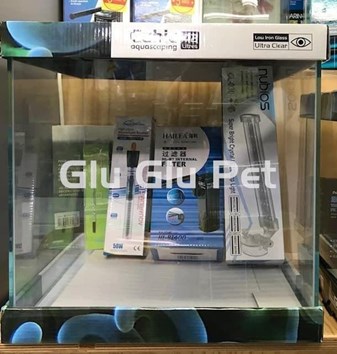
1.2.- FILTER FOR YOUR SHRIMP:
Every aquarium needs a filter and if you want to mount a shrimp and get good results, a good filter is essential.
The filter not only cleans floating debris, but also harbors crucial beneficial bacteria that allow your aquarium to become a healthy ecosystem.
An aquarium filter is responsible for collecting debris and all kinds of dirt from the water. In addition, thanks to the filter material, it will have the capacity to house the necessary bacterial colony.
Basically the filter will allow your shrimp farm to become a habitable and healthy ecosystem for your shrimp.
Any aquarium regardless of size needs a filter.
There are different types of filters for aquariums; the internal filter, the backpack filter and the external filter.
Each with its advantages and disadvantages.
There are various types of shrimp filters and each has its own pros and cons. The type of filter you should choose will depend on the liters of your aquarium. The most important thing is that the filter is safe for aquarium shrimp.
This is usually not difficult to achieve, even with powerful filters that have the ability to suck up any shrimp that get too close. You can buy a filter protector in the form of a sponge that covers the inlet of most filters.
Some of the commonly used filters for shrimp tanks are:
Sponge Filter: The favorite choice of most professional shrimp farmers.
Sponge filters are extremely soft and 100% safe for shrimp.
They are air-fed and powered by an air pump. If your aquarium is larger than 30 liters you may need to choose something better.
Internal Filter: The most popular filtration option for beginners.
These work great for prawns, there are even special ones for prawns that won't suck up your baby shrimp.
Backpack filters: These are generally perfect if you do not want a filter inside your aquarium, as its name suggests, you hang it on the back.
It draws the water through an inlet tube, passes it through the filter chambers and then returns it to the tank through a cascade system. You will need a filter guard if you want to use one of these or you will be vacuuming up baby shrimp.
External filter: The best if you really want good water quality, since they are relatively large and have a lot of space for the filter material.
Although there are external filters for nano aquariums.
This type of filter is recommended for aquariums from 60 liters onwards.
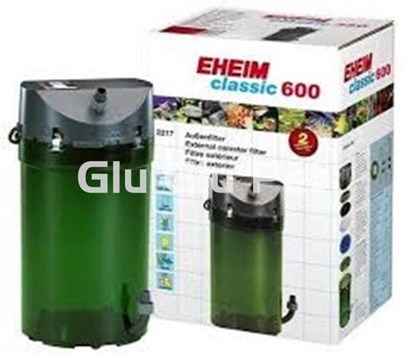
1.3.- TEMPERATURE OF THE SHRIMP:
Prawns, just like fish, need parameter stability, and temperature is one of them.
1.4.- HEATER FOR THE GAMBARIO:
Although most species of shrimp are fine at room temperature, it is best to install a heater to maintain a stable temperature of 24-26 degrees.
This is because most rooms suffer from temperature changes throughout the day, differences between day and night, leaving the door open, etc.
These oscillations also influence the temperature of the aquarium, which can cause problems if the difference is too great.
After all, shrimp don't respond well to sudden changes in their environment.
A thermostat for your shrimp tank is designed to turn on as soon as the temperature drops below a certain point, to keep the tank stable.
Unless the room temperature is very constant at all times, a heater is therefore a necessity.
Make sure you buy a high-quality model – cheap heaters can occasionally malfunction and the resulting temperature swings can cause problems with these sensitive invertebrates.
There is an old rule that says the following: 1 watt of heater power is equivalent to 1 liter of aquarium water.
Therefore, a 50w heater is enough for a 50 liter aquarium.
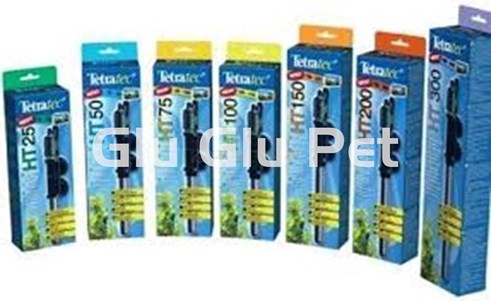
Thermometer:
To keep the temperature in your shrimp tank as stable as possible, you will need to really know what temperature it is at.
A thermometer is a must-have piece of equipment for any shrimp farmer.
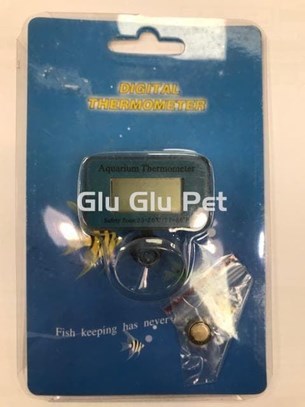
1.5.- FANS FOR THE GAMABARIO:
Summer is the biggest enemy that aquarists have, since the temperature of the rooms increases and consequently the water in the aquarium as well.
To solve this there are fans for aquariums.
Basically the fans are placed focused towards the surface of the water, managing to lower the temperature of the aquarium by several degrees.
The disadvantage of this is that it produces a lot of evaporation, so it will be necessary to monitor the water level in the aquarium to replenish the evaporated water.
1.6.- SUBSTRATE FOR GAMBARIO:
There are many types of substrates, sands or gravels for aquariums. If you look at the experts and breeders, there is one type that stands out above the rest: the black substrate. This type of substrate enhances the color of the shrimp and any plant you may have.
You should know that not all substrates are the same. There are some that are neutral, there are some that are nutritious and there are some that modify the parameters of the aquarium water.
1.6.1.- INERT SUBSTRATES:
They are mainly made up of gravel or sand.
These substrates do not provide any type of nutrient or fertilizer for the plants.
Advantages:
- They give the aquarium naturalness, those that are not painted.
- There are different granulometries and colors.
- Cheaper than the rest.
Disadvantages:
- It is not suitable for aquariums with plants that require nutritious substrates to live.
- Some can vary the values of water such as pH or gh.
- The paint used to stain the substrate can be toxic to shrimp.
- Not recommended for use in shrimp with caridinas.
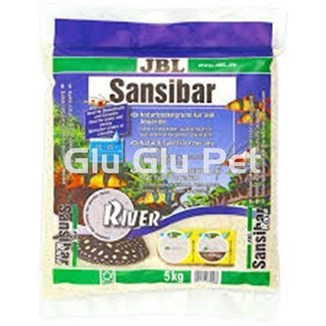
1.6.2.- SUBSTRATES FOR PRAWNS:
These substrates are designed to be used in specific aquariums for shrimp.
They are clayey and reduce the pH and kh values in a stable way.
Akadama, although it is a substrate for bonsai, has been used in shrimp beds for years, since it has the same characteristics and benefits as specific substrates.
Advantages:
- Ideal for Caridines.
- Its main colors, brown or black. highlight the color of the prawns.
- They reduce water values such as pH or kh and keep them low and stable.
Disadvantages:
- Over time they become saturated and stop reducing pH and kh.
1.7.- ILLUMINATION OF THE GAMBARIO:
In a shrimp farm where the main protagonists are the prawns, not much light is necessary.
Therefore the lighting should not be very powerful.
The moment you decide to introduce a plant in the shrimp tank, then yes, the lighting begins to matter.
Remember this word: lumens, as they refer to the amount of light that the screen emits.
To know what light an aquarium/shrimp needs, the lumen of the screen is divided by the total amount of water in the aquarium, thus giving rise to the lumen/liter ratio.
Each aquarium needs a specific amount of lumens according to the requirements of its plants, for example:
- Low requirements: between 0 and 15 lumens/litre.
- Medium requirements: between 15 and 25 lumens/liter.
- High requirements: between 25 and 35 lumens/liter.
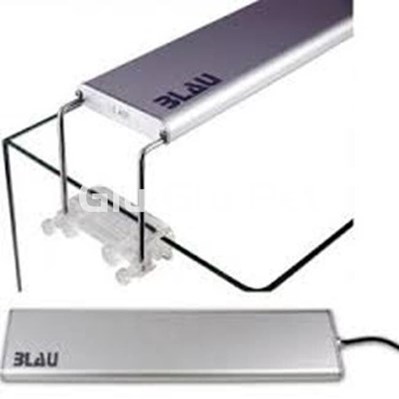
1.8.- THE WATER OF THE GAMBARIO:
If you think that all types of water, whether tap or bottled, is suitable for shrimp, you are totally wrong.
In order to successfully maintain a shrimp farm, you must know what the water parameters are and how to measure them.
1.8.1.- PH OF THE GAMBARIO:
The pH is a measure of the acidity or alkalinity of a solution, in this case the shrimp water.
This parameter is important, because depending on the type of shrimp, they move in one pH range or another.
The pH has a scale that goes from 1 to 14, with 1 being the most acidic and 14 being the most alkaline. The neutral value is right in the middle, 7.
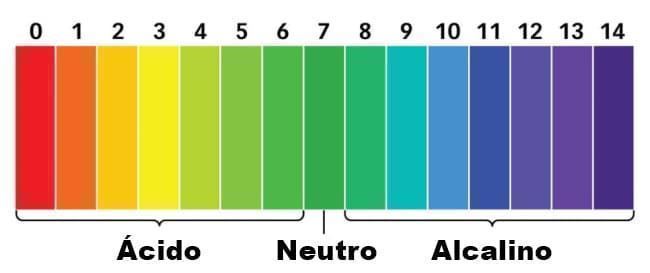
There are different methods to measure pH:
- Digital pH meter: it is the most accurate method.
- Drop test: using a reactive liquid, the water is stained in color and allows the pH to be identified using a color table. It is one of the most used methods.
- Strip test: these are strips of paper that, when reacting with the water in the sample, change color and allow the pH to be identified using a color chart.
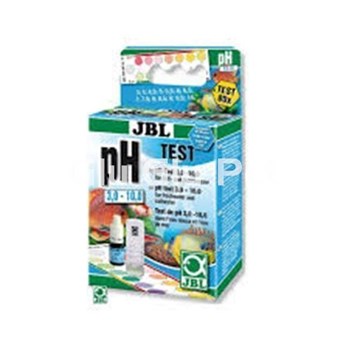
1.8.2.- KH OF THE GAMBARIO:
The kH measures temporary hardness and is linked to the ability of the water to maintain a stable pH.
A high kH implies a rise and stabilization of the pH (buffer effect or buffer). In turn, a low kH implies a drop and imbalance of the pH.
There are several ways to measure the kH of the water in a shrimp tank:
Digital kH meter:
The digital kH meter is the most accurate method to find out the kH of the aquarium. The problem with these meters is that they are quite expensive.
Drop test: it is a cheap meter and its operation is based on a chemical reaction.
It is very simple to use:
- Water is introduced into the bucket.
- The reagent is then added drop by drop.
- After each drop, shake until the blue color turns green and then turns yellow. (These test colors vary depending on the brand or manufacturer of the test.)
- Each drop indicates a degree of kH.
Strip test: these are strips of paper impregnated with a chemical substance that reacts with the water in the sample and allows the kH to be identified using a color chart.
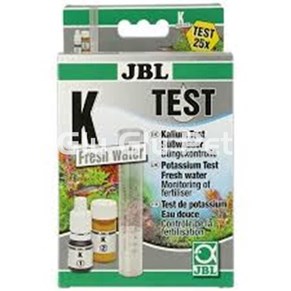
1.8.3.- GH OF THE GAMBARIO:
The gH or water hardness is the sum of all the dissolved salts in the water.
As a guideline, gH can be classified into:

As in the previous parameters, there are several ways to measure the gH of the water in a shrimp tank:
Drop test:
- Water is introduced into the bucket.
- The reagent is then added drop by drop.
- After each drop, shake until the red color turns green. (These colors may vary depending on the brand or manufacturer of the test).
- Each drop indicates a degree of gH.
Strip test: like the pH and kH tests, they are reactive paper strips. When reacting, it changes color and allows gH to be identified using a color chart.
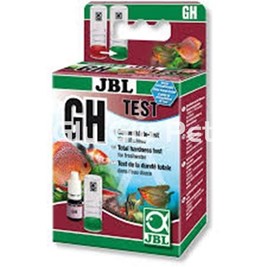
1.8.4.- THE TDS:
TDS come from the acronym in English total dissolved solids, which in Spanish means total dissolved solids.
Said in a simpler way: the famous TDS are the total concentration of dissolved substances in the water.
WATER HARDNESS RATIO TABLE
ppm Degree of hardness
0-50 Very soft, or very weak mineralization.
50-140 Soft, with weak mineralization.
140-240 Slightly hard, mineralized.
240-350 Hard, quite mineralized.
+ 350 Very hard, highly mineralized.
Basically what you should know about this parameter is that depending on the prawns, caridines or neocaridines, you must have a range of specific values.
Values higher than what is indicated will, for example, prevent the prawns from breeding or even cause them to die.
Caridines: 150-180 TDS
Neocaridines: 180-300 TDS.
1.8.5.- THE CHLORINE OF THE WATER:
Chlorine is a disinfectant present in both tap water and bottled water and adding it to the shrimp tank by mistake can be fatal to your shrimp.
Luckily chlorine is easy to remove.
There are two methods:
- On the one hand, the slow and free method by evaporation, the chlorine evaporates in approximately 24 hours.
- On the other hand, the fast and chemical one, using water conditioners, usually act in 10 min.
Another substance used for water disinfection is chloramines.
Companies that make tap water drinkable often use chlorine or chloramines to disinfect. There are even those that use both substances at the same time.
The problem is that chloramines do not evaporate.
Don't worry, chloramines can be removed by using specific aquarium water conditioners.
You should look closely at the label, as there are conditioners that only remove chlorine and those that remove both chlorine and chloramines.
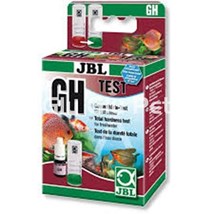
1.8.6.- AMMONIA, NITRITOD AND NITRATES:
These substances are very toxic to fish and shrimp.
Nature is wise and luckily thanks to the nitrogen cycle, both ammonia and nitrites are transformed into nitrates, nitrates are less toxic and, in addition, plants take advantage of it in the form of fertilizer.
In any case, its concentration must be reduced by changing the water.
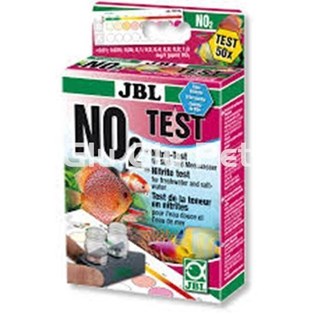
1.8.7.- CHANGE THE WATER VALUES:
Now you know the basic parameters of water.
The first thing you should do before introducing shrimp into your aquarium is to measure at least the pH and GH value of the water that comes out of the tap.
Below I indicate what values both caridines and neocaridines need.
But now, you have to know those values first.
If these values are within the tolerable range for shrimp, you can use tap water in your gamabrio.
On the other hand, if the values are above what is recommended, you will need osmosis equipment and use specific salts.
1.8.8.- SALTS FOR PRAWNS:
Using specific salts for prawns or prawns is very simple and they are basically used to adapt the values of the aquarium water to the needs of the prawns that we are going to have.
For example, if you use very soft water with low mineralization, it is possible that the pH, Gh or even TDS are below the minimum values for neocaridines.
So you will need to add salts that will raise those values to get to the desired value.
There are several brands that sell salts, there are those that only raise GH (ideal for caridines) and others that raise GH and KH (for neocaridines).
The most used and recommended are these.
1.8.9.- OSMOSIS EQUIPMENT:
Reverse osmosis equipment is used in aquariums in order to purify tap water and have much purer water.
An osmosis system is capable of eliminating chlorine, metals such as iron or copper, and all kinds of chemical residues that the water may contain, thus reducing the pH, KH and GH values.
Therefore, if your tap water is hard and has a high pH, you may want to invest in one of these kits and then use specific salts to adjust to the ideal values that your shrimp need.
1.9.- PLANTS FOR THE GAMBARIO:
In the case of wanting to introduce plants, I recommend that you use plants with few or low requirements. They have the advantage that they require little light and do not need a fertilization routine or Co2.
Java moss (Vesicularia dubyana):
- Temperature: 18-28º.
- Position: On rocks or logs.
- Required lighting: low.
- Difficulty: easy.
- Growth rate: medium.
- Ph: 6.0 – 7.5.
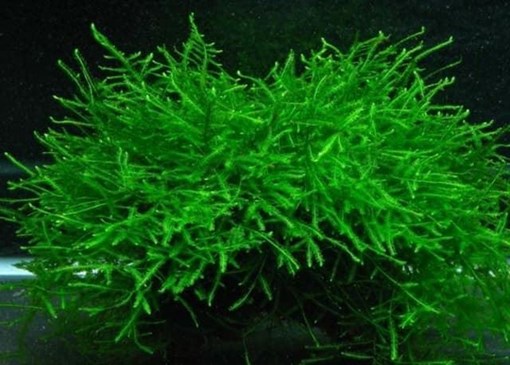
Christmas moss (Vesicularia montagnei):
- Temperature: 17-26º.
- Position: On rocks or logs.
- Required lighting: low – high.
- Difficulty: medium.
- Growth rate: medium.
- Ph: 5.0 – 7.5.
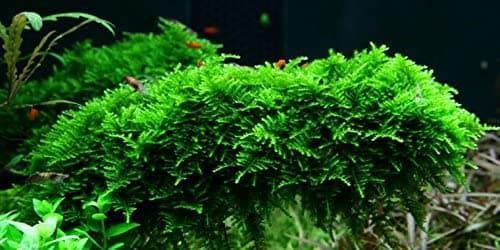
Flame Moss (Taxiphyllum sp. 'Flame'):
- Temperature: 18-28º.
- Position: On rocks or logs.
- Required lighting: low.
- Difficulty: easy.
- Growth rate: medium.
- Ph: 6.0 – 7.5.
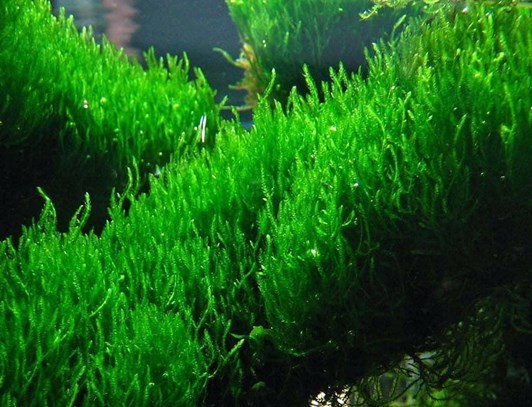
Fissidens fontanus:
- Temperature: 16-28º.
- Position: On logs or rocks.
- Required lighting: medium.
- Difficulty: easy.
- Growth rate: medium.
- Ph: 6-8.
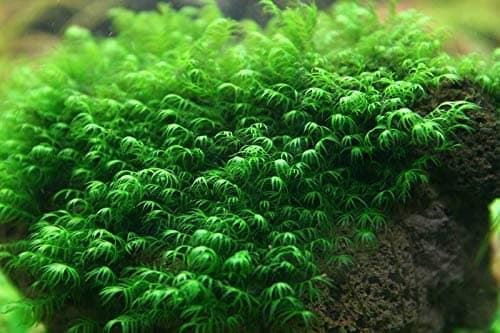
Riccia (Riccia fluitans):
- Temperature: 17-29º.
- Position: On rocks or logs.
- Required lighting: medium-high.
- Difficulty: medium.
- Growth rate: medium.
- Ph: 5.0 – 7.5.
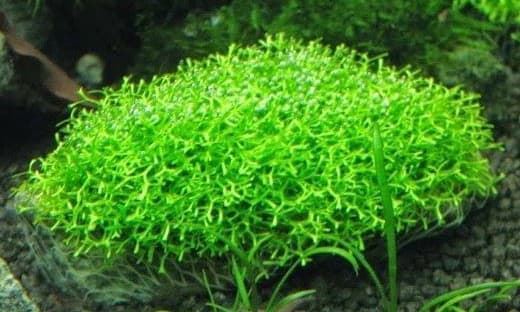
Pellia (Monosolenium tenerum):
- Temperature: 5-30º.
- Position: on the substrate or decoration, without the need for grip.
- Required lighting: low.
- Difficulty: easy.
- Growth rate: medium.
- Ph: 5.8 – 7.8.
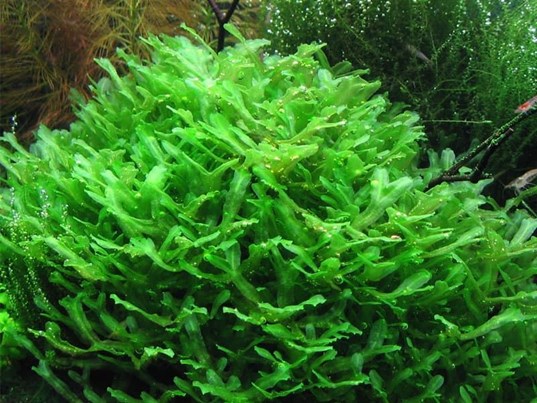
Duckweed (Lemna minor):
- Temperature: 5-30º.
- Position: floating.
- Required lighting: low.
- Difficulty: easy.
- Growth rate: high.
- Ph: 6.0 – 8.0.
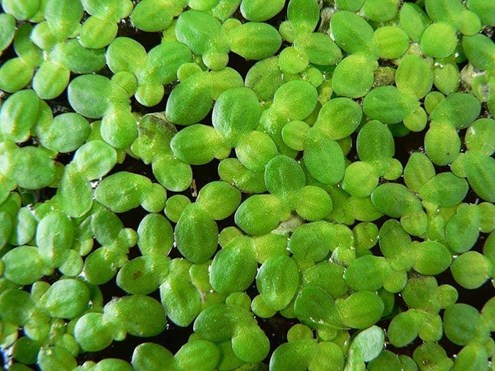
Limnobium laevigatum:
- Temperature: 20-30º.
- Position: floating.
- Required lighting: high.
- Difficulty: easy.
- Growth rate: medium.
- Ph: 6.5 – 7.5.
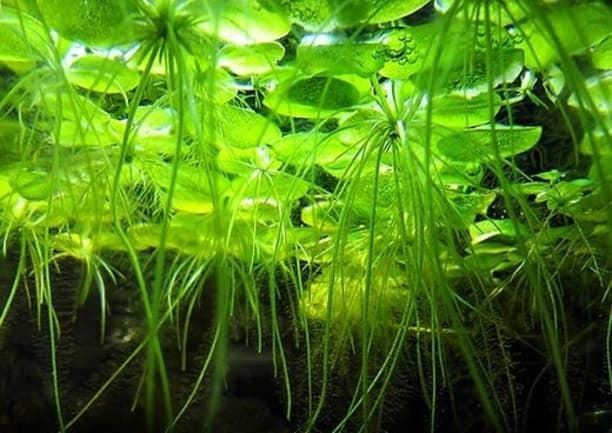
1.9.1.- PLANTS NOT RECOMMENDED FOR SHRIMPS:
Although it seems impossible, there are 3 types of plants not recommended for an aquarium with shrimp:
- Anubias.
- Bucephalandras.
- Cryptocorynes.
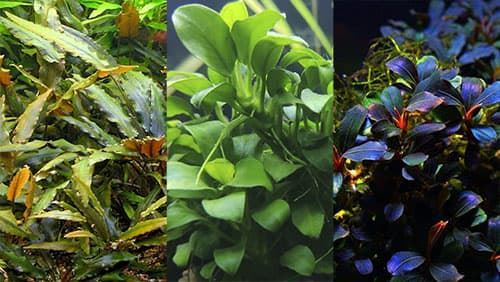
2.- TYPES OF PRAWNS FOR YOUR SHRIMP:
2.1.- NEOCARIDINS:
- Name: Neocaridine.
- Scientific name: Neocaridine cf. Davidi.
- Aquarium size: Recommended from 30 liters.
- Difficulty: Easy.
- Size: 2.5 – 3cm.
- Temperature: 18 – 23°C.
- AP: 6.8 – 7.3.
- GH: 5-20.
- KH: 2–10.
- TDS: 200-300.
- Diet: Omnivore.
- Behavior: Peaceful.
- Life expectancy: 2 years.
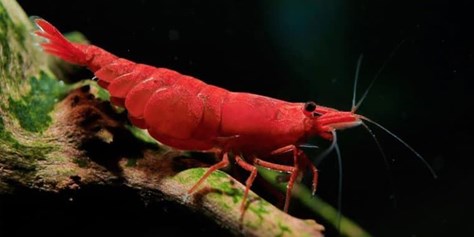
2.2.- CARIDINES:
- Name: Carina.
- Scientific name: Caridina cf. Cantonensis.
- Aquarium size: Recommended from 30 liters.
- Difficulty: Medium.
- Size: 2.5 – 3cm.
- Temperature: 21 – 23°C.
- PH: 6.6 – 6.9.
- GH: 4-6.
- KH: 0-1.
- TDS: 140-160.
- Diet: Omnivore.
- Behavior: Peaceful.
- Life expectancy: 1-2 years.
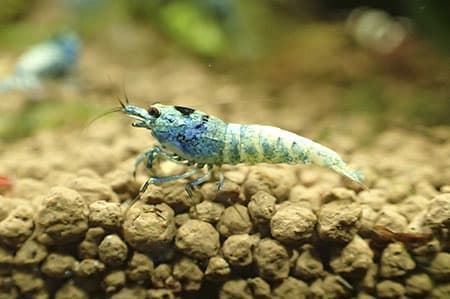
2.3.- GHOST SHRIMP:
- Name: Ghost Shrimp.
- Scientific name: Macrobrachium lanchesteri.
- Aquarium size: Recommended from 40 liters.
- Difficulty: Easy.
- Size: 5-10cm.
- Temperature: 23 – 28°C.
- PH: 6.5 – 7.5.
- GH: 7-15.
- KH: 5-8.
- TDS: 120-200.
- Diet: Omnivore.
- Behavior: The males are usually aggressive and very territorial among themselves. Small fish can be attacked.
- Life expectancy: 2-3 years.
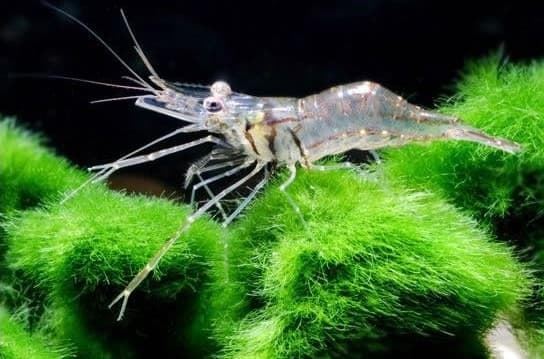
2.4.- CARIDINA DENNERLI (SULAWESI):
- Name: Caridina Cardinal.
- Scientific name: Caridina sp. Dennerli.
- Aquarium size: Recommended from 30 liters.
- Difficulty: Medium.
- Size: 2-3cm.
- Temperature: 26 – 30°C.
- PH: 7.5 – 8.5.
- GH: 7-9.
- KH: 4-6.
- TDS: 100-200.
- Diet: Omnivore.
- Behavior: Peaceful.
- Life expectancy: 1-2 years.
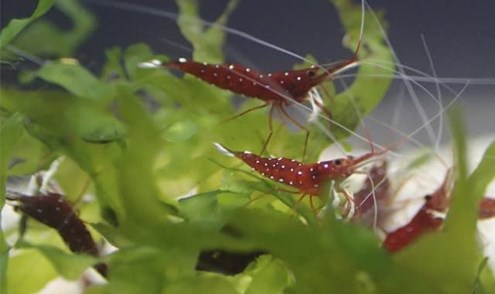
3.- NUTRITION OF PRAWNS:
Success in a shrimp farm lies in several factors, but one of the most important is the good nutrition of the shrimp. You must provide them with varied and quality food.
The easy option is through specific commercial products.
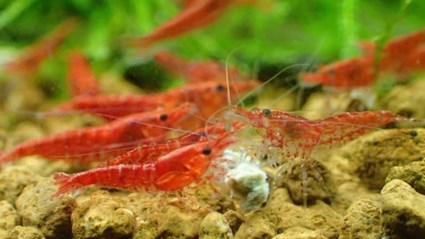
4.- REPRODUCTION OF PRAWNS:
The mating:
The mating between a male and a female happens quickly, practically a few seconds.
Before that, we will see the male chasing and harassing the female.
Until finally the male will hook the female by the abdomen and deposit the sperm.
fertilization:
The females usually have the eggs in the "saddle", which is where they have the ovaries.
They are small undeveloped eggs, when we see them we say that they are preovated.
When the male deposits the sperm in the female, the small eggs will go down from the "saddle" to the belly and get fertilized on the way.
The pregnancy:
A female is officially pregnant when we see that she has the eggs in her womb, to this we say that she is ovate.
Pregnancy usually lasts about 4 weeks, depending on the species.
The female carries the eggs in her belly and occasionally moves them with her legs.
This is because you must "aerate" them, thereby preventing the appearance of fungi.
The number of eggs is undetermined, if the female is young or new, she probably has fewer eggs than one that is older and has already had several clutches.
We can also observe that the female has lost eggs or they have fallen; this may be due to several factors.
The female may be stressed for some reason, the female may be sick, the eggs may have a problem, various factors may occur.
But if the conditions are right and the females are happy, they do not stop breeding, remaining ovate a few days after hatching their eggs.
Egg development.
Depending on the species, the eggs usually take about 4 weeks to hatch.
The color of the eggs can vary depending on the species, white, yellow, transparent, dark.
In some prawns, it is possible to know if their eggs are about to hatch, thanks to the fact that eggs will appear in the “saddle” (pre-ovada); although this is not infallible and in many species we will not be able to appreciate this detail.
If you have very good eyesight or a good camera, you can also know if the eggs are a few days away from hatching, since the eggs will “appear” with eyes.
This is an indicator that the small prawns are practically formed.
What you should keep in mind:
- Water changes favor mating.
- The eggs take approximately 4 weeks to hatch.
- A novice female will breed you less than one that has already bred several times.
- The color of the eggs usually varies depending on the type of shrimp.
- If the female detects any problem in the eggs, she will get rid of them.
5.- CARE OF PRAWNS:
Prawns are generally a bit more delicate than fish and everyday things of our day to day can make them die.
Those who discover aquarium shrimp are fascinated by their unique physical characteristics, ease of maintenance and the many advantages they represent in the aquarium alongside other fish.
These small invertebrates are gaining more and more popularity thanks to the little space they require and the little care they require, however, that does not mean that we should not pay attention to their diet or disease prevention.
If you are considering starting a shrimp or shrimp aquarium and you want to learn how to take better care of them, knowing which shrimps are recommended for community aquariums for beginners, their basic care or the type of water they require will be essential.
Freshwater prawns are part of an extensive and admirable world within the aquarium hobby, freshwater invertebrates.
Within the category of invertebrates we can differentiate between crustaceans and snails, which are gaining more and more presence in freshwater aquariums due to their great abilities to combat and keep algae at bay in planted aquariums.
It is a wonderful world that captivates you, and that, no matter how many years you have been keeping aquariums, when you discover it you fully immerse yourself.
Within the freshwater prawns for aquariums we can find a large number of species, the vast majority obtained thanks to the selection and generation of new lines by breeders.
If you have been enjoying aquarium hobby for a long time but you have never kept shrimp, you will feel like in your first days studying new aspects such as TDS: total dissolved salts, or EC; the conductivity of the water.
Aquarium shrimp require excellent parameter stability and the maintenance or care of a shrimp tank differs to a greater or lesser extent from that of a traditional aquarium with fish, so below you can see the main aspects to take into account.
Main care of shrimp in freshwater aquariums:
- Freshwater prawns are very sensitive to nitrogenous compounds, ammonia and metals such as copper.
- Before paying with a commercial product, thoroughly review all the compounds it contains and it is also advisable to review the main materials used in the aquarium, whether they are filters, heaters, pruning tools, as they can release metals in the aquarium because they do not They are conditioned for prawns.
Along with this, we do not recommend mixing prawns with fish, except in the case of Caridinas Multidentata or Japonicas, since they will either be the food of said fish or they will remain hidden and you will not be able to enjoy them to the fullest.
Even so, if you want to keep them together with fish, you should be aware that they will spend most of their time hidden and will not be as active as in a specific aquarium for them.
Also, it is essential to have floating plants such as:
- Limnobium laevigatum.
- Duckweed.
- salvinia natans,
- Riccia,
- Fox tail.
Well, they are great consumers of nitrates.
In addition to these, it is mandatory to introduce mosses where the shrimp can graze and feed.
They require water rich enough in minerals to carry out the molt correctly, reinforcing their exoskeleton after said process.
For this, commercial salts or homemade methods are usually used to modify only the GH of our shrimp.
As for the size of the aquarium, shrimp tanks are usually small compared to freshwater fish tanks.
To begin with, the ideal is a shrimp tank of around 30 or 40 liters, because the smaller it is, the more difficult it is to stabilize the parameters.
The substrate is another essential aspect.
It will depend on the type of prawns that we are going to keep but in general, it must be either inert so that it does not modify the parameters, or clayey to acidify and soften the water.
Taking into account the latter, there are commercial substrates that stabilize the ideal parameters for different varieties.
Lighting is not a fundamental aspect but we must guarantee that it is of the spectrum and of the necessary lumens for the correct growth of the plants and mosses that we keep in the shrimp tank.
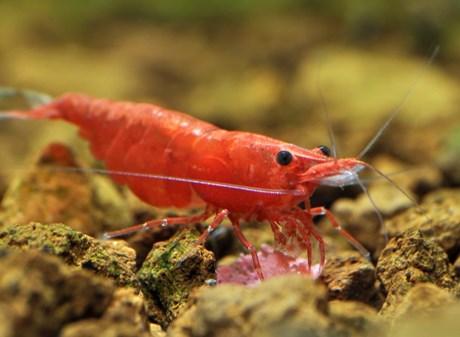
6.- FISH THAT COEXIST WITH PRAWNS:
If your idea is to combine fish and shrimp, you should know that, in some cases, shrimp can easily become food.
These are some fish compatible with shrimp:
- Corydoras Pygmaeus.
- Dwarf Cichlids.
- Neons.
- Barbels.
- Molly's.
- Discus fish.
You should never add Elephant fish or Platys fish.
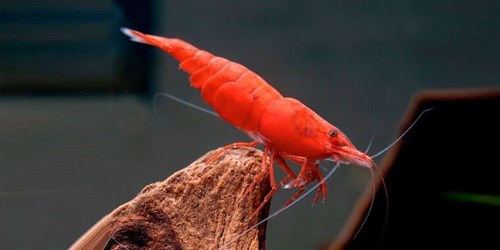
7.- PRAWNS DISEASES:
Prawns have an enviable immune system: they can eat carrion or fish carcasses without getting sick.
In any case, we will pay attention to the appearance of parasites, especially worms such as Scutariella japonica.
We will be able to observe in the body of the shrimp some small white filaments that adhere to it.
On this occasion we will focus on one of the diseases that causes the lowest number of deaths in invertebrate aquarium facilities, both for individuals and professionals.
We refer to the well-known porcelain disease or "cooked shrimp".
This disease, which can increase mortality in aquariums, is caused by a microsporidium known as Thelohania, which embeds itself in the muscle tissue of shrimp.
It is easy to identify the disease by its symptoms: this unicellular parasite attacks muscle tissue and spreads rapidly, making locomotion increasingly difficult for the shrimp.
That is why in a couple of days it ends the life of the affected individual, presenting the appearance of a cooked shrimp.
This also helps us rule out whether a shrimp is affected by said parasite or by a bacterial infection.
We will see the first symptoms in the body of the shrimp, which will present the internal white tissue and that will spread from the base of the head to colonize the rest of the body.
That is when the individual can barely move.
We will observe stunted and spasmodic movements of the pleopods, we can even see the shrimp trying to swim aimlessly.
This is where the main problem comes from, and it is that this disease spreads rapidly in the aquarium, because the infected specimens are attacked by the rest of the population, which will eat it even if it is still moving, becoming infected in the process.
For this reason, the main step in combating the disease is, firstly, to remove the infected specimens, as well as all the carcasses, before they can be eaten by the rest of the shrimp.
We will change the water and above all we will siphon the aquarium eliminating as much organic matter as possible.
The high temperature benefits the parasite, and that is why in the summer months this disease wreaks havoc in the aquariums of fans.
We will try to keep the temperature below 23º C.
Porcelain Disease Treatments:
In particular, we must pay special attention to the elimination of corpses, remains and infected individuals.
We recommend the use of Terminalia catappa leaves in the aquarium and the feeding with crushed garlic to promote the defenses of our shrimp as much as possible.
Finally, we have collected reports of the use of Furanace, Furanol II and PolyGuard.
Well, today I am going to give you the main 15 reasons why prawns usually die without any explanation or obvious sign of premature death.
1- Sick or very stressed prawns:
At Glu Glu Pet we maintain the best quality standards, so that our prawns come in the best conditions, we always take care of our animals and maintain care, nutrition and cleanliness so that our animals live as well as possible and our customers enjoy the best quality , for this we choose the best distributors in the sector.
The stress of the trip, change of water, new aquariums, put a lot of stress on the prawns, causing them to die after a few days after introducing them into the aquarium. At Glu Glu Pet we know about all these conditioning factors, and we try to ensure that they receive the best care.
2- Chlorine:
Chlorine is lethal for prawns, if we have not properly dechlorinated the water and eliminated the chloramine we will find dead prawns and we will not know the reason for their death.
3- Bad tap water with toxic metals:
Apart from chlorine there are also other substances in the water that need to be removed.
If you use tap water, you not only have to treat it with anti-chlorines and anti-chloramines, but also other treatments.
Tap water contains many dissolved metals, such as copper, which are lethal to our shrimp.
Not controlling the parameters that our water has is usually one of the most probable causes of the deaths of our tenants.
4- Excess food:
The excess food ends up breaking down and generating ammonia and ammonium spikes.
And this translates into shrimp death.
5- Uncontrolled CO2:
Although the PH has already been discussed, one of the factors that greatly alters the PH in the aquarium is CO2.
Not having it well controlled can make the PH fluctuate and destabilize it.
6- A bad acclimatization:
One of the main causes of unexplained death is due to poor acclimatization.
Many times we are in a hurry and we don't give the prawns time to get used to the new parameters.
The thermal shock of these is very important when putting them inside the aquarium without having carried out a good acclimatization.
7- Bacterial death:
That the bacterial colony in an aquarium dies is a big problem.
And many times we do not act when this happens.
When it happens, the ammonia and ammonium spikes skyrocket, the nitrites and nitrates dance like never before.
8- Excess of males in proportion to females:
An excess of males can lead to the death of a female when she molts.
The males become hysterical, harassing her in such a way to mate that they stress and overwhelm them to death.
9- Poor maintenance of shrimp farms:
This is vital, due to negligence or laziness we are not regular with the cleaning of the aquarium, the feeding, the water changes and the control of the parameters.
This in turn causes salts to accumulate, there may be spikes in some parameter or worse, ammonia spikes.
Poor maintenance of a shrimp tank can cause a large number of deaths.
Luckily, the maintenance of shrimp tanks takes little time and can be done quickly.
But even so, you have to do them and not always leave them “for tomorrow”.
10- Bad genetics:
Just like humans, there are people who tend to get sick more frequently, the same thing happens with prawns.
Shrimp with poor genetics are more likely to become ill and succumb to small variations in aquarium water parameters.
11- Domestic accidents:
There are not a few cases that an aerosol has been used near aquariums and some toxic substance has fallen into the water.
Deodorants, insecticides, lacquers, air fresheners, the bad thing about this is that it usually causes the death of almost all the inhabitants of the aquarium.
That is why it is always recommended to have the aquariums covered.
12- A sudden variation of the PH:
It has always been said that several TDS or GH is deadly for prawns, let's see, it is, but a sudden change in PH is much more harmful to our prawns.
13- Water changes that are too big and sudden:
The changes have to be regular and not excessive.
20% every week or ten days.
14- Too sudden changes in temperature in water changes:
Not doing a gradual water change causes the temperature of our aquarium to vary.
That is why you have to make slow changes.
To give the incoming water time to equalize the aquarium water, altering its temperature to a minimum.
15- Excess temperature in summer:
In summer it is very hot and that warms the room where the aquariums are.
And this at the same time heats the water of the shrimp.
If the temperature rises above 26º C, you can already start collecting corpses.
Especially if you have caridines that are much more sensitive to changes in temperature.
Conclusion: Note that we could say that the main causes of death of our shrimp is mainly our fault. We have to be aware that his life is in our hands and not take his care so lightly.
You have to use common sense and not be lazy.
Dedicate some time to our prawns and they will greatly appreciate it.
You will see them running around your shrimp farm, enjoying a good life and raising mini shrimp like crazy.
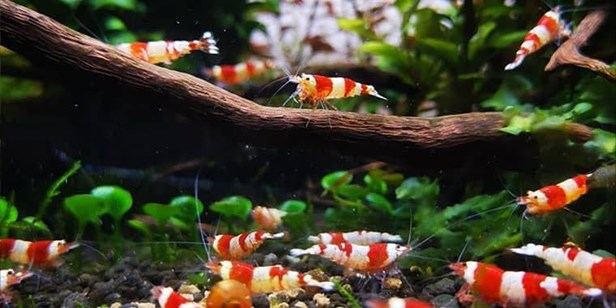
Last entries
How to feed bettas October 5, 2018
Bettas arrive at Exotic-shrimp September 4, 2018
Explanation of all the stages that a shrimp goes through. July 13, 2018
latest comments
chengkai in The shrimp water has turned white
Joaquín in The water of the shrimp has turned white
Laia in RED CHERRY

